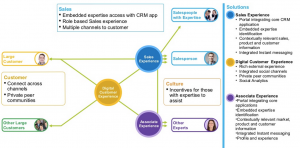Rob Novak and Mac Guidera presented tips on how to make a pilot in social software successful. First why pilot? A pilot is critical to success because it provides for an experimental trial on a small scale for the future change that you anticipate.A well run pilot reduces the risk of large scale failure and improves chances of strategic success. You only have to look at the roll out of the Healthcare.gov website in October 2012 to see how a large scale failure can happen.
What are key components of a pilot? Pilots should have a defined scope, examples include:
- a specific business unit
- a class of employees
- a region
- a particular business process.
A pilot should also be short term, but each pilot has to determine the length of time based on several factors:
- How big is the scope?
- Are there technologies hurdles that must be overcome?
- Is there sufficient hardware to start fast?
- Are personnel available for training? Are these people willing and wanting to participate?
- How long will it take so determine measurable results?
When conducting a pilot, you must have clear goals. Goals will vary by company and what you want to pilot. Little academic and real-life work has been focused on pilot goals, however Rob has identified some Goal Driven Software Development Processes that may be helpful in setting goals for a pilot.
Collaborative Goal Identification is one process. This starts with a top-level goal and then drives down to sub-goals.
Goal, Question, Metric (GQM) is another approach developed by NASA and others. Here you have a conceptual, operational and quantitative levels for goals. Each of these goals have specific metrics.
IBM has a set of collaboration solutions patterns that focus on ROI and strategic process. These  patterns show how social can be used in the processes and provide a starting point for a pilot program. Patterns are available for:
patterns show how social can be used in the processes and provide a starting point for a pilot program. Patterns are available for:
- Customer Engagement (shown here)
- Innovation
- Recruiting & Onboarding
- Supply Chain
- Mergers & Acquisitions
- Workplace & Public Safetfy
- Expertise & Knowledge.
Gaining executive support is always mentioned as critical for success, but nobody explains how to pursue executive support. Here are some tips for help find the right executive:
- Open Door Policy
- Active involvement
- Must be identified at the beginning
- Must have same level of decision making influence as the individuals controlling the budget
- Project should be linked to the executive sponsor’s area of expertise.
Here are some guiding principles for a pilot:
- Select fertile ground since a pilot is an experiment, not proving what you already know
- Pilot team is critical, both participants and sponsors
- Design around business applications or benefits NOT tools
- Define scope but encourage experimentation
- Design pilot to learn lessons
- Provide training and guidance
- Create visibility
- Monitor progress and cut or expand
Of course, you need to measure outcomes based on your goals. During the pilot you want to have interim assessments to evaluate the effectiveness of particular aspects of the pilot.
